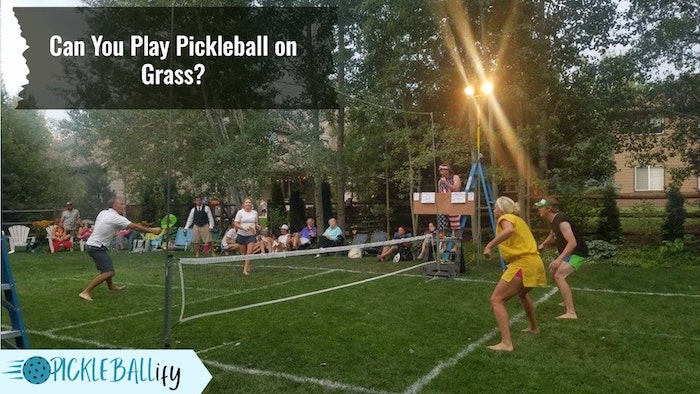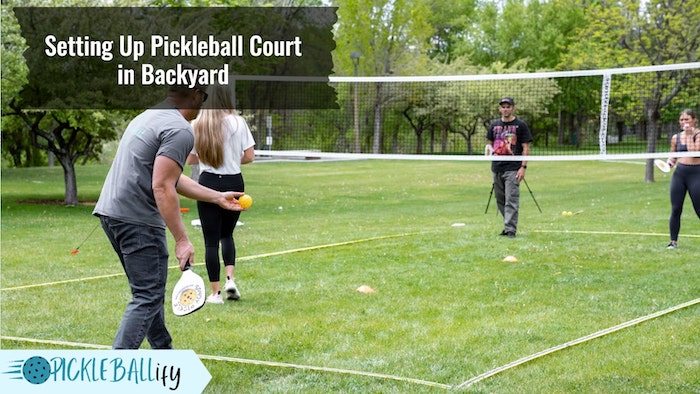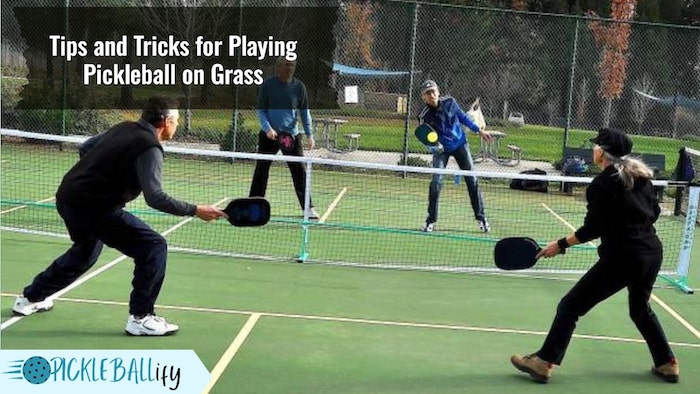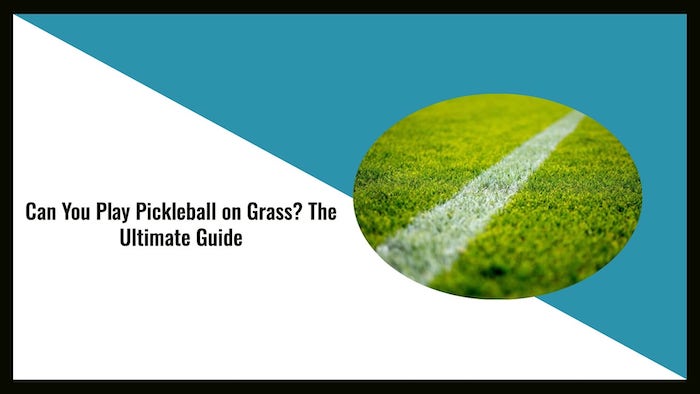Welcome to the exciting world of pickleball, where passion, ability, and creativity combine! If you enjoy pickleball, you’ve probably seen typical courts consisting of asphalt, concrete, or indoor gym flooring.
But have you ever considered playing pickleball on grass? Players are continuously pushing the boundaries and discovering new playing surfaces as the popularity of this exciting sport grows.
In this article, we will look at the benefits and drawbacks of playing pickleball on grass, how to build up a grass pickleball court in your backyard, what sort of ball you should use for grass pickleball, and some pickleball on grass tips and techniques.
So grab your paddle, put on your court shoes, and join us as we explore the undiscovered terrain of pickleball on the green! Get ready to have a pickleball experience like no other!

How to Set Up a Grass Pickleball Court in Your Backyard
You will need some equipment and preparation if you want to play pickleball on grass in your backyard. Here are some instructions for establishing a grass pickleball court in your backyard:
1) Find a suitable spot: A grassy area at least 44 feet long and 20 feet wide is required. This is a standard pickleball court, with a 7-foot non-volley zone (often referred to as the kitchen) on either side of the net.
More space around the court is also desirable for safety and movement. Look for a site with no dips, holes, bumps, or debris that might disrupt your game or cause harm. Avoid areas with sprinkler systems or animal droppings, which can make the grass wet or muddy.

2) Cut the grass: The grass should be kept as short as possible, ideally using a lawn mower or weed whacker. This will improve the bounce of the ball and make the lines more visible. Grass clippings should also be swept or raked away from the court.
3) Mark the lines: The court lines must be marked using a temporary, visible, and long-lasting material. You may draw the lines yourself with tape, chalk, paint, or rope, or you can get a pickleball court kit that includes the lines and posts. You must measure and mark the following lines.
- The baseline: This is the line that connects the two ends of the court. It should be 22 feet distant from the net and parallel to it.
- The sideline: This is the line that runs down the middle of the court on both sides. It should be 10 feet distant from the net and perpendicular to it.
- The centerline: This is the line that divides the court into two equal halves. It should run parallel to the baseline and at right angles to the non-volley zone line.
- The non-volley zone line: This line denotes the non-volley zone (also known as the kitchen). It should be 7 feet distant from the net and parallel to it.
- The service court line: This is the dividing line between the two equal service courts. It should go from the sideline to the centerline and connect them at right angles.
4) Set up the net: A net 36 inches high along the sides and 34 inches high in the centre is required. You may use a portable pickleball net system, which includes poles and a net, or you can make do with a badminton or volleyball net.
You will need to attach the net to the poles or stakes and make sure it is taut and level. You will also need to adjust the height of the net if necessary with a measuring tape or a ruler.
Pros and Cons of Playing Pickleball on Grass
Playing pickleball on grass is possible, but it has some pros and cons that you should be aware of. Here are some of them:
Pros:
- Easier setup: You can set up a game wherever you like, as long as you have a large enough backyard or a local park.
- Gentle on your body: Playing on grass can reduce the impact and stress on your joints and muscles, especially if you have pain or issues with hard surfaces.
- Heightened awareness: Playing on grass can help you practice your volleys and reaction time, as you have to hit the ball in the air and not wait for the bounce.

Cons:
- Less bounce: The pickleball will not bounce properly on grass, as it is a spongy and soft surface. This makes it harder to get under the ball and over the net, and also makes dinks almost impossible to return.
- Slower bounce: The ball will also bounce slower on grass, which means you have to hit it harder to keep the rally going. This can affect your momentum and strategy.
- Slippery or uneven surfaces: Grass can be slippery or uneven, especially if it is damp or not well-maintained. This can cause you to slide or lose your balance, which can be dangerous if you have ankle or knee stability issues.
- Court lines are hard to see: Painting or marking lines on grass is harder than on concrete or asphalt. This can make it difficult to see the boundaries and the non-volley zone.
What Kind of Ball Should You Use for Grass Pickleball?
The type of ball you choose for grass pickleball can have a significant impact on your gameplay and performance. The basic pickleball ball is a lightweight plastic ball with holes suitable for hard courts. However, this type of ball may not operate well on grass since it may bounce too low or too unpredictablely.
A rubber ball, which is heavier and more durable than a plastic ball, is a superior choice for grass pickleball. A rubber ball will bounce higher and more consistently on grass, making hitting and rallying simpler. A rubber ball will also survive longer on grass than a plastic ball since it will not fracture or shatter as quickly.
Some examples of rubber balls that are suitable for grass pickleball are:
- Spalding High Bounce Ball: This is a little rubber ball with a smooth surface and a strong bounce. It is great for grass pickleball since it can withstand any terrain or weather condition. It is also reasonably priced and widely available in most stores and online.
- JUGS Bulldog Polyball: This is a medium-sized rubber ball with a dimpled surface and a moderate bounce. It is intended for baseball pitching machines, but it may also be used for grass pickleball because of its ability to simulate the spin and movement of a plastic ball. It’s also long-lasting and resistant to wear and tear.
- Penn Pressureless Tennis Ball: This is a huge fuzzy-surfaced rubber ball with a low bounce. It is intended for tennis practice, but it may also be used for grass pickleball since it offers greater control and accuracy than a plastic ball. It also has a long lifespan and is ideal for all weather situations.
Tips and Tricks for Playing Pickleball on Grass
Pickleball on grass may be fun as well as demanding, but it also necessitates certain changes in strategy and technique. Here are some pickleball tips and strategies for playing on grass:
- Wear proper grass-playing shoes with sufficient grip and support. Shoes with smooth bottoms or spikes that might harm the grass should be avoided.
- Use tough paddles and balls that can survive the challenges of playing on grass. Paddles with soft or porous surfaces that might absorb moisture or debris from the grass should be avoided. Use balls with wider holes to decrease drag and improve bounce on grass.
- Adjust your stance and footwork to accommodate for the ball’s low and inconsistent bounce on grass. To reach the ball, stay low and bend your knees more than normal. To prevent sliding or stumbling on the grass, move your feet fast and gently.

- Adjust your swing and shot selection to account for the low and uneven bounce of the ball on grass. Use more topspin and less backspin to make the ball bounce higher and faster on grass. Aim for deeper and higher shots to keep your opponents back and prevent them from attacking the net. Avoid drop shots or dinks that may not clear the net or bounce too low on grass.
- Be prepared for unpredictable bounces and rallies on grass. Expect the ball to bounce differently depending on the direction, speed and spin of the shot. Anticipate where the ball will land and react quickly to adjust your position and shot. Be ready for longer and more varied rallies on grass, as the ball may slow down or speed up depending on the grass condition.
FAQs
Absolutely! While pickleball is traditionally played on hard courts, such as asphalt or concrete, playing on grass is possible with some considerations.
The rules of pickleball remain the same, regardless of the playing surface. However, players may need to make adjustments to their gameplay due to the unique characteristics of playing on grass.
Playing pickleball on grass can be challenging for beginners due to the different playing surface and ball response. It may require additional skill and adaptability. Beginners may benefit from starting on traditional hard courts before transitioning to grass.
While most pickleball tournaments are played on traditional hard courts, there are some grass court tournaments organized specifically for the unique challenge and excitement that grass can offer. Check with the tournament organizers for specific rules and requirements
Well, It’s a Wrap
In conclusion, playing pickleball on grass can be a thrilling and unique experience that challenges players to adapt their game to a different playing surface. While grass courts can present challenges such as uneven surfaces and variable ball bounce, they also offer benefits like softer footing and distinct ball response.
With proper preparation, including appropriate footwear, the use of outdoor pickleball, and awareness of court conditions, playing pickleball on grass can be a fun and enjoyable alternative for players looking to add variety to their game.

